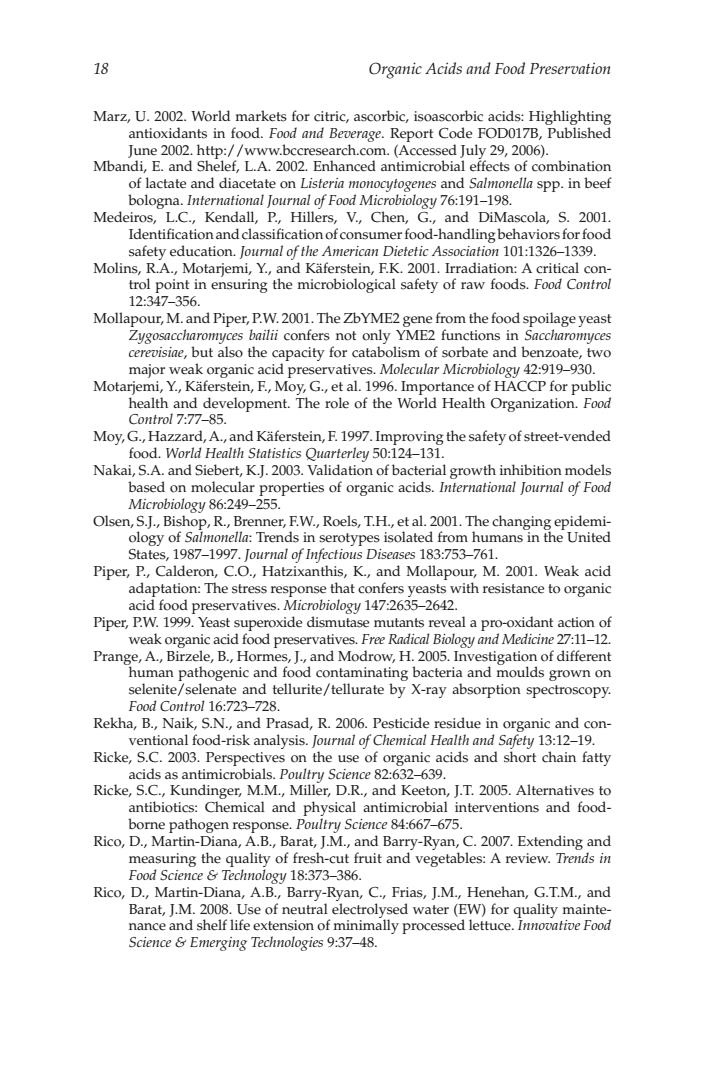正在加载图片...

8 Organic Acids and Food Preservation Marz U 2002 World markets for citric.ascorbic.isoascorbic acids Highlight age.Report Code FOD017B,Published June 2002.http://www.bccresearch.com.(Accessed July 29,2006). Mbandi,E.and Sh ef,LA.2002.Enhanced antimicrobial ffects of combination of lactate and diacetate on Listeria monocytogenes and sammonela spp.in beet Medeiro 3y76 rfood-banin Mascola.S.2001 safety education.Journal of the American Dietetic Association 101:1326-1339 Molins,R.A.,Motarjemi,Y.,and Kaferstein,F.K.2001.Irradiation:A critical con- in ensuring the microbiological safety of raw toods.Fd Coutro in spoilage yeast Mollaour,M and Piper,P.W.2001.The ZbyMom the foo no nd he maior weak organic acid nre vatives.Molecular Microbiolo 42:919-930 Motarjemi,Y.,Kaferstein,F,Moy,G.,et al.1996.Importance of HACCP for public health and development.The role of the World Health Organization.Food Moy,G nd Kafe World Healh s ,E1997. mprov the safety of street-vended Nakai.S.A rt.K.I.2003.Validat based on molecular Microbiology 86:249-255. Olsen,S.J.,Bis op,R.Brenner,F.W.,Roels,T.H,et al.2001.The changing epidemi- Piper,P,Calde M.2001.Weak acid a acid food pr servatives.Microbiologv 147:2635-2642 ce to organ Piper,P.W.1999.Yeast superoxide dismutase mutants reveal a pro-oxidant action of weak organic acid food preservatives.Free Radical Biology and Medicine 27:11-12. of different noulds grown on h m16723272 ellurite/tellurate X-ray ab sorption spectroscopy. Rekha,B.,Naik,S.N.,and Prasad,R.2006.Pesticide residue in anic and con ventional food-risk analysis.Journal of Chemical Heathand sae hw1312-19 Ricke,S.C.2003.Perspectives on the use of organic acids and short chain fatty acids as antimicrobi 1ce82:6 639 Ricke,S. nger er, and K 08工20s Alterna R4667675 nterventions an Rico.D.Martin-Diana.A.B.Barat.I.M.and Barry -Rva C 2007 Extending and measuring the quality of fresh-cut fruit and vegetables:A review.Trends in Food Science Technology 18:373-386. Rico,D.Martin-Diana,A.B.,Barry-Ryan,C.Frias,J.M.Henehan,G.T.M.and Barat,J.M.200 0m0937-48 ally processed18 Organic Acids and Food Preservation Marz, U. 2002. World markets for citric, ascorbic, isoascorbic acids: Highlighting antioxidants in food. Food and Beverage. Report Code FOD017B, Published June 2002. http://www.bccresearch.com. (Accessed July 29, 2006). Mbandi, E. and Shelef, L.A. 2002. Enhanced antimicrobial effects of combination of lactate and diacetate on Listeria monocytogenes and Salmonella spp. in beef bologna. International Journal of Food Microbiology 76:191–198. Medeiros, L.C., Kendall, P., Hillers, V., Chen, G., and DiMascola, S. 2001. Identification and classification of consumer food-handling behaviors for food safety education. Journal of the American Dietetic Association 101:1326–1339. Molins, R.A., Motarjemi, Y., and Käferstein, F.K. 2001. Irradiation: A critical control point in ensuring the microbiological safety of raw foods. Food Control 12:347–356. Mollapour, M. and Piper, P.W. 2001. The ZbYME2 gene from the food spoilage yeast Zygosaccharomyces bailii confers not only YME2 functions in Saccharomyces cerevisiae, but also the capacity for catabolism of sorbate and benzoate, two major weak organic acid preservatives. Molecular Microbiology 42:919–930. Motarjemi, Y., Käferstein, F., Moy, G., et al. 1996. Importance of HACCP for public health and development. The role of the World Health Organization. Food Control 7:77–85. Moy, G., Hazzard, A., and Käferstein, F. 1997. Improving the safety of street-vended food. World Health Statistics Quarterley 50:124–131. Nakai, S.A. and Siebert, K.J. 2003. Validation of bacterial growth inhibition models based on molecular properties of organic acids. International Journal of Food Microbiology 86:249–255. Olsen, S.J., Bishop, R., Brenner, F.W., Roels, T.H., et al. 2001. The changing epidemiology of Salmonella: Trends in serotypes isolated from humans in the United States, 1987–1997. Journal of Infectious Diseases 183:753–761. Piper, P., Calderon, C.O., Hatzixanthis, K., and Mollapour, M. 2001. Weak acid adaptation: The stress response that confers yeasts with resistance to organic acid food preservatives. Microbiology 147:2635–2642. Piper, P.W. 1999. Yeast superoxide dismutase mutants reveal a pro-oxidant action of weak organic acid food preservatives. Free Radical Biology and Medicine 27:11–12. Prange, A., Birzele, B., Hormes, J., and Modrow, H. 2005. Investigation of different human pathogenic and food contaminating bacteria and moulds grown on selenite/selenate and tellurite/tellurate by X-ray absorption spectroscopy. Food Control 16:723–728. Rekha, B., Naik, S.N., and Prasad, R. 2006. Pesticide residue in organic and conventional food-risk analysis. Journal of Chemical Health and Safety 13:12–19. Ricke, S.C. 2003. Perspectives on the use of organic acids and short chain fatty acids as antimicrobials. Poultry Science 82:632–639. Ricke, S.C., Kundinger, M.M., Miller, D.R., and Keeton, J.T. 2005. Alternatives to antibiotics: Chemical and physical antimicrobial interventions and foodborne pathogen response. Poultry Science 84:667–675. Rico, D., Martin-Diana, A.B., Barat, J.M., and Barry-Ryan, C. 2007. Extending and measuring the quality of fresh-cut fruit and vegetables: A review. Trends in Food Science & Technology 18:373–386. Rico, D., Martin-Diana, A.B., Barry-Ryan, C., Frias, J.M., Henehan, G.T.M., and Barat, J.M. 2008. Use of neutral electrolysed water (EW) for quality maintenance and shelf life extension of minimally processed lettuce. Innovative Food Science & Emerging Technologies 9:37–48